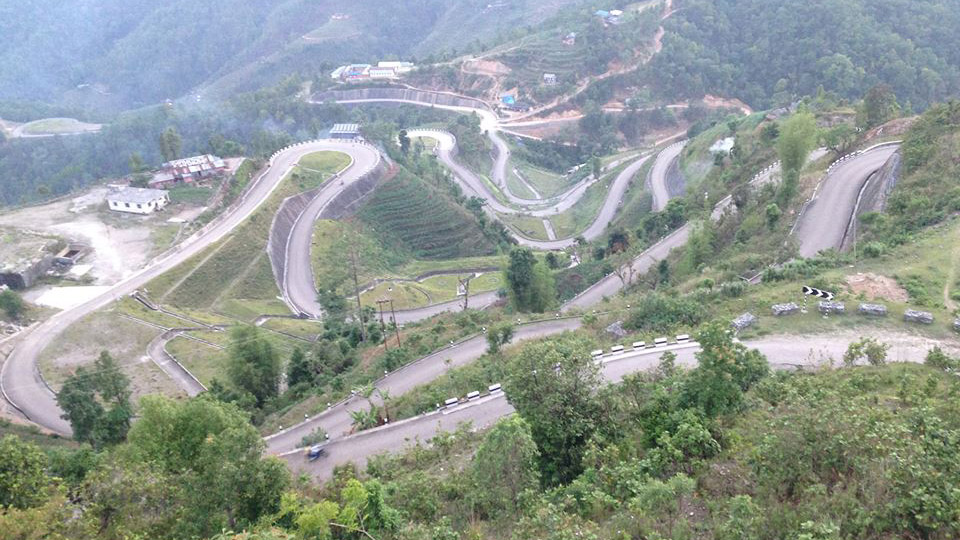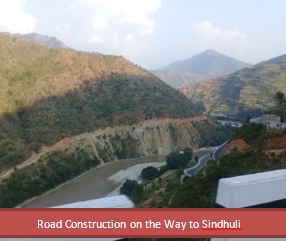Discourage Unplanned Equipment Based Road Construction


Local governments have given priority to heavy equipment based rural road construction that neither take account of sustainable environment management and climate change resilient ecosystem nor contributes to improving livelihood opportunities of rural poor.
Rural Road in Priority
Local elected representatives have given priority on the road expansion as an entry point of development. Chairperson of Shailung Rural Municipality, Dolakha has allocated 70% of annual development budget of NRs 8.8 million for fiscal year 2017/18 in rural road up gradation and expansion. Similarly, almost NRs. 2.5 million has been set aside by Rajdevi Municipality of Rautahat for constructing rural roads in fiscal 2017/18, Said Rajdevi Municipality Mayor Mr. Dhirendra Kumar Singh. According to Mr. Singh, he wants to maintain road network to connect all municipality ward offices, and widening of all roads by his next five year tenure.
The election manifestos of the all major political parties stresses on leading the country towards prosperous path. Road network expansion has been considered as an essential component of the prosperity. National Reconstruction Authority (NRA)’s policy requires constructing all Earthquake Damaged houses as soon as possible that has pressurized Earthquake victim local communities to open new treks for accessing construction materials such as cement, rod, and stones upto door steps in all Earthquake Impact households. Further, there is a tendency that rural community want to construct road upto their home yard.
It was informed that about 25% of the total elected mayors in Rautahat District are registered contractor. Almost 50% elected representatives linked with the occupation of contractors. Rajdevi Municipality Mayor was of the opinion that being himself as a high profile contractor, he could accomplish all the annual planned activities of the Municipality by mobilizing his own equipment such as vacuolar loader, excavator, grader, roller and tractor. Even, he can use expertise of his own Engineers in designing and estimation of all the planned road projects of the Municipality, Said Mr. Singh.
Equipment Vs Labor Based Technology
Since the early 1990s, when resources and authority for spending began to be channeled through local bodies, the use of heavy equipment for road construction such as bulldozers and excavators started to increase. Further, the desire to establishing road connections aroused quickly also resulted in the increased use of unsustainable road construction approaches and methods. Unsustainable roads are those that have: (i) no drainage arrangements; (ii) high gradient; (iii) no protection structures in critical places; (iv) no biological protection; and (v) no operation and maintenance arrangements or fund; etc.
Rural road construction has been guided by two types of technologies; Labor Based (LB) Road or Equipment Based (EB) Road. LB technology (green road) has been gradually replaced by EB technology (non-engineered road) over the last 15-20 years with use of heavy equipment like bulldozers and excavators. Rural road construction will continue to be a priority of local government at least until next five years as local governments are continuing road construction in name of development.
The Ministry of Federal Affairs and Local Development (MoFALD) through Poverty and Environment Initiative Programme under Local Governance and Community Development Programme carried out a study in Makawanpur and Dolakha Districts on Economic Analysis of Local Government Investment in Rural Roads in 2011. The study revealed that development of road network is a consensus priority at local levels, which has expedited with promulgation of Local Self Governance Act, 1999.  The study revealed that heavy equipment based construction has started to substitute the traditional labor based and green road construction technologies in Nepal. Both technologies have their respective plus and minus points. Labor based technologies are considered environment-friendly and pro-poor with economic returns of 30% more than equipment based technology, but the technology is awfully slow and expensive.
The study revealed that heavy equipment based construction has started to substitute the traditional labor based and green road construction technologies in Nepal. Both technologies have their respective plus and minus points. Labor based technologies are considered environment-friendly and pro-poor with economic returns of 30% more than equipment based technology, but the technology is awfully slow and expensive.
On the other hand, the heavy equipment based technologies generally have exactly opposite characteristics. Equipment based roads, can give good results, if planned properly. Wherever possible a combination of both approaches should be used equipment based technology are cheaper and faster while the labor based technology are more sustainable and pro-poor. Therefore, to ensure sustainable road development that contributes to maintain environment as well as support uplifting livelihood of rural poor, three major interventions are to be implemented as an entry point. Firstly, labor based technology should be encouraged and particularly emphasized in poverty-ridden areas. Use of heavy equipment especially bulldozers and rock-blasting materials should be discouraged.
 However, there are certain situations when equipment based technology can be efficient and less damaging. These situations are in (i) road widening; (ii) ridge alignments; and (iii) long alignments through unpopulated areas that require the establishment of labor camps under LB methodology.
However, there are certain situations when equipment based technology can be efficient and less damaging. These situations are in (i) road widening; (ii) ridge alignments; and (iii) long alignments through unpopulated areas that require the establishment of labor camps under LB methodology.
Secondly, Environment consideration should be mainstream into local development planning process. Roads should be a part of the District Transport Master Plan (DTMP). No road should be financed by local bodies, unless it is included in the DTMP, adopt various tools like Rapid Environment Assessment, Initial Environment Examination and Environment Impact Assessment as and when needed, while designing the road, prepare public service packages in agriculture and the social sectors (health, education, etc.) Finally, no roads should be started without sufficient funds at hand or without having assured funding sources, all rural roads should have adequate operation and maintenance funds and such funds must be complemented by beneficiary contributions raised from the increased income resulting from the road. A system of reasonable taxing of vehicles and goods movement can also be developed for this purpose.
One of the root causes of unsustainable rural road construction at the local level is the shortage of technical manpower and lack of adequate knowledge with local decision makers of economic and environmental benefits of labor based technology. Although financial resource availability as well as roles and responsibilities at local level have increased considerably over the years, the availability of technical manpower has remained the same.
Conclusion
To ensures sustainable environment management and uplifting socio-economic condition of rural poor it is high time to make available necessary technical man power as soon as possible at local level. Moreover, local government should construct road networks based on Transportation Master Plan. Over and above, elected representatives should be educated towards pros-cons of using LB and EB technologies based rural road construction. If the timely capacity development action is not taken, the ongoing heavy equipment based rural road construction that has been incentivized local government for adopting EB rural roads will lead the country towards misfortune in the near future.
The author is an Independent Environment Consultant

 Ek Raj Sigdel
Ek Raj Sigdel




Feedback